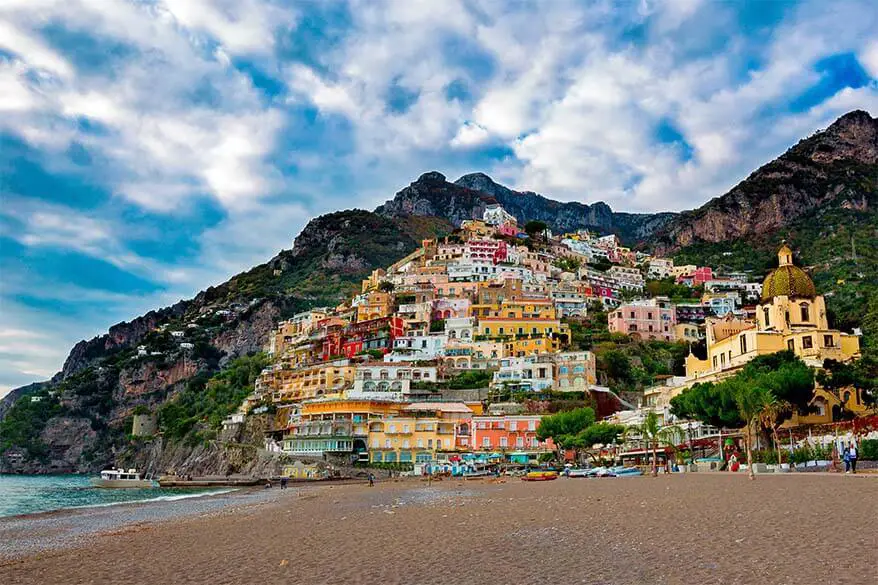Karnataka is one of the most beautiful states in India, with an age-old history and amazing culture and tradition. The state of Karnataka has 8 famous dances which are popular in the Indian state and across the world.
Some dances have historical significance, some are performed in temples as offerings to God and Goddesses, and some are done as part of festivals, but what all of these dances have in common is that they are beautiful to watch!
Read on to know more about this popular folk dance of Karnataka which everyone must watch at least once in their lifetime.
1. Dollu Kunitha
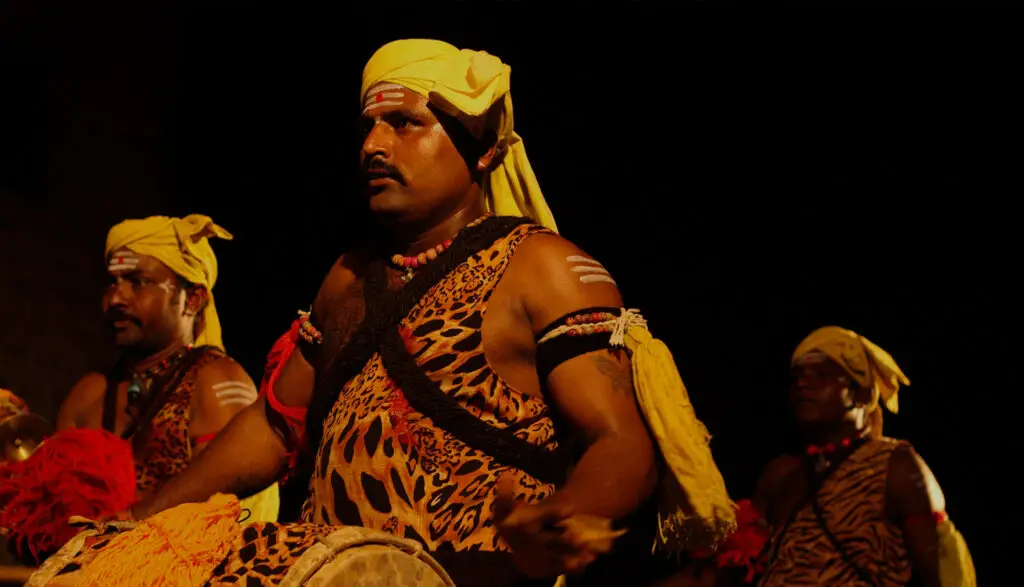
There was a demon Dolla-asura who worshipped Lord Shiva. Lord Shiva appeared and said him to ask for a boon from him. The asura asked a boon. He requested lord shiva to grant him immortality of or gave him the power to swallow lord Shiva himself. Lord Shiva got angry. He has the obligation to fulfill one of his wishes. He fulfilled his second wish. When Asura swallowed him, Lord shiva started growing big. The Dolla Asura was not able to bear the pain. He pleaded with Lord shiva to come out of his mouth.
Shiva tore the demon and came out of his mouth. With the demon, Shiva made Dollu also known as the drum. He gave that drum to his devotees Halu Kuruba” tribes in Shimoga. Since that day, this tribe follows the tradition in form of Dance today.
Dollu Kunitha is the aggressive dance form of Lord Shiva. It is believed Lord Shiva performs this dance when he is angry or upset. This dance requires a lot of energy to perform.
Dollu Kunitha is a traditional dance form of Karnataka and is performed with a large group of dancers ( usually 10-12 drummers, accompanied by the beating of drums. The dancers form intricate patterns with their movements and the drums provide a lively background beat. The dance is performed in a semi-circle. This dance is typically performed during festivals, and other special occasions to celebrate the gods. It is sure to mesmerize audiences and provide a memorable experience.
The drummers are a key component of the performance as they are responsible for setting the rhythm and maintaining it throughout the entire performance. The dancers also work together to create an elaborate choreography while they move around a circle, which makes it even more interesting to watch.
The most important part of this dance is the sound created by striking two sticks on a kunitha (giant drum) which adds to its uniqueness. They have their own beats created by two groups – Halu Kuruba tribe and Dasari Yelava tribal groups in Shimoga district of Karnataka State.
These dances have been passed down through generations by these tribes because they serve religious purposes; hence, these dances are being performed for centuries now
2. Kamsale Dance

Kamsale is one of the most famous and beloved dances of Karnataka which is performed by devotees of Lord Mahadeshwara. This dance is famous in Mysore, Karnataka region. It is also known as ‘Shiva Kamsale. The dance is performed by menfolks in Mysore village.
In Kamsale, Kamsale is an brass-made instrument that is used as an instrument as well as a prop in the dance. The Kamsale instrument is played in pairs. The size of the instrument is about a man’s palm.
The dance is generally performed in groups of 10-12 people and it is usually performed by men in the Halu Kuruba tribe in the Chamarajanagara district. This tribe is known to be a devotee of Lord Shiva.
This dance is generally performed at a 3-day car festival at Male Mahadeshwara Hill temple. It is located on the outskirts of Mysuru. It is celebrated during the Deepavali festival. Besides this, Kamsale Dance is part of various cultural programs in South Karnataka. This dance is showcased in many South films also such as Jogi and Janumadha Jogi.
3. History of Bolak-aat (Bolak Dance)
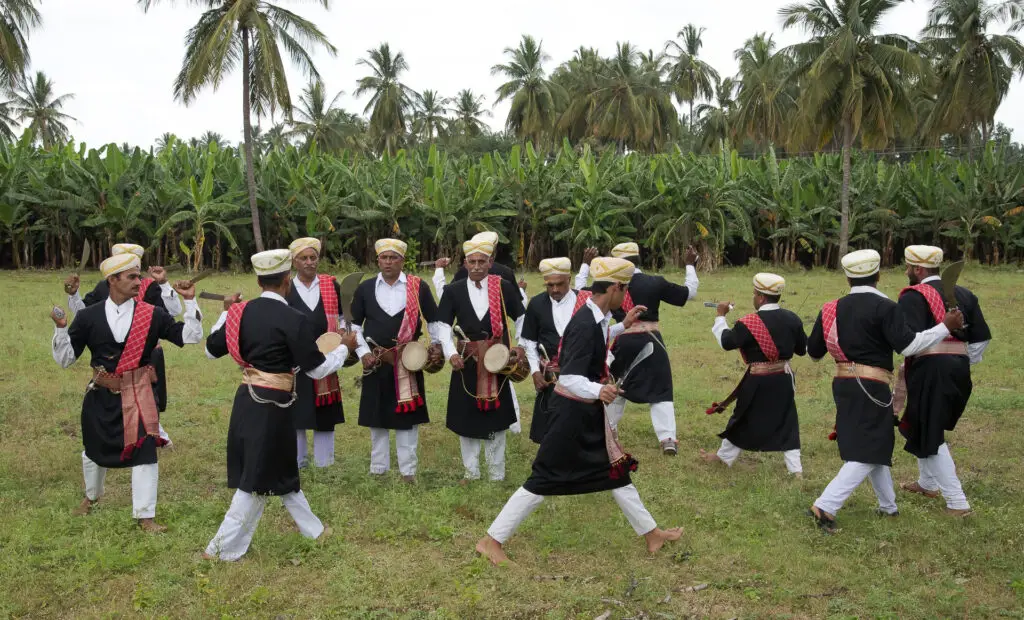
Bolak-aat is one of the most famous dances in Karnataka and it is believed to have been performed since ancient times.
It is believed that when Bolak was one of the dances Lord Vishnu performed when he was on a mission to kill the demon ‘Bhasmasura. The dancer dresses in Kodva dress and dance is performed by Kodva men in front of the oil lamp and in the open field. The dance performers hold Kodava ( a short sword) on one hand and ‘Chavari’ which means Yak animal’s fur on the other hand.
Dudi is the musical instrument that is used for this dance. The dance is performed to celebrate the heroic activities of the Kodava gods.
The musical instrument used for this dance is called ‘Dudi’. Dudi is an hourglass-shaped drum that is used to provide rhythm.
This folk dance is based on the brave activities of the Kodava gods. Dance is a form of entertainment and has been passed down through generations. Bolak-aat literally translates to dance with sticks and is characterized by the use of sticks as props.
The dancers perform Bolak-aat on the beats of drums, which are accompanied by singing. During the performance, they move the sticks around in a circular motion while also twirling them in their hands. This form of dance has its roots in folk music and culture.
Bolak-aat is an important part of many festivals in Karnataka, such as Dussehra and Deepavali. During these festivals, it is customary for people to celebrate with this traditional dance form.
In recent years, Bolak-aat has become popular in many cities across India and even abroad. Many schools and colleges organize performances of this dance form as part of their cultural activities.
If you ever get a chance to witness this traditional dance form, do not miss it! The sheer energy and enthusiasm of the dancers will surely make you smile!
4. Bhootha Aradhane
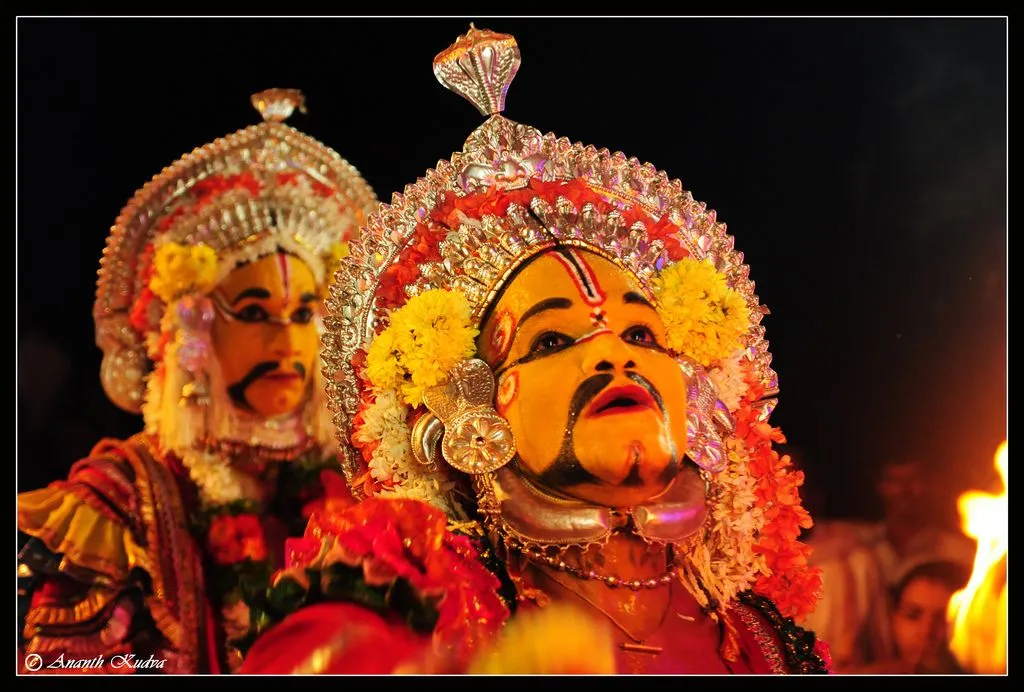
Bhootha Aradhnane is one of the famous dance forms in Uttar Karnataka. in Bhoot Aradhane bhoot means ghost. In ancient times, bhoot was called to shiva deities of shiva bhaktas. The obligation of these people is to worship lord shiva and protect dharma.
In this dance. performers face their paint, wear skirts and wear various types of jewelry and prepare their look to resemble ghosts. The dance is performed by men in colorful costumes. The dance is performed in the month of January and after the annual festival.
In Bhootha Aradhane, the dance is enhanced by dancers in colorful costumes. The highlight of this folk dance is the amazing spirit of the people watching it and the energy of the performers. This folk dance truly captures the vibrancy of Karnataka’s culture and art forms. Be sure to check out Bhootha Aradhane if you’re ever in Karnataka and get a chance to witness its magnificence firsthand.
5. Nagamandala Dance
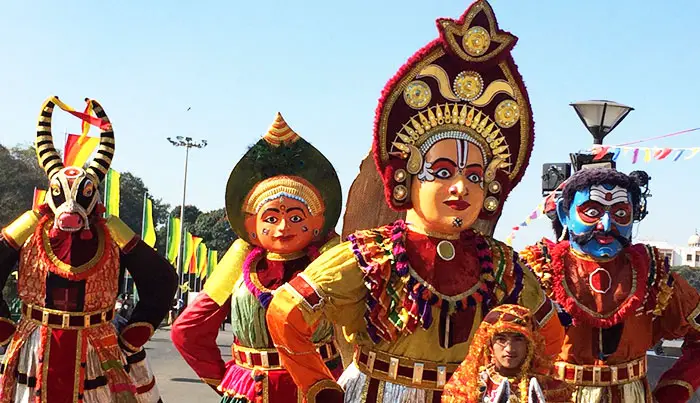
Nagamandala is one of the most celebrated and cherished dances of Karnataka, performed in honor of the Snake Goddess Manasamma. It is said to have originated centuries ago and is still an integral part of Karnataka’s culture and tradition.
The dance is famous in the coastal districts of Dakshina Kannada and Udupi. This dance portrays the divine unification of female and male snakes. In this dance, all the performers are traditionally dressed.
There are generally 2 people required to perform the act. The dance is performed at the night and ends at the dawn. The first priest inhales the areca flower and acts male snake. The second priest also called Nagakannika (female serpent) sings a song and dances around a detailed serpent design.
The design is made on the sacred ground with given colors which are – white mud, red, green, yellow, and black. The colors are prepared from ingredients, such as lime powder, turmeric powder, paddy husk, green leaves powder, and others.This form of dance is rarely seen nowadays.
Nagamandala is a great way to witness the grandeur and artistry of traditional Karnataka culture. Whether you are a local or a traveler visiting Karnataka, you will be mesmerized by this mesmerizing and captivating performance!
To witness Nagamandąla art you need to go through the South or Dakshin Kannada and its details are also advertised in the local newspaper
6. Veeragase
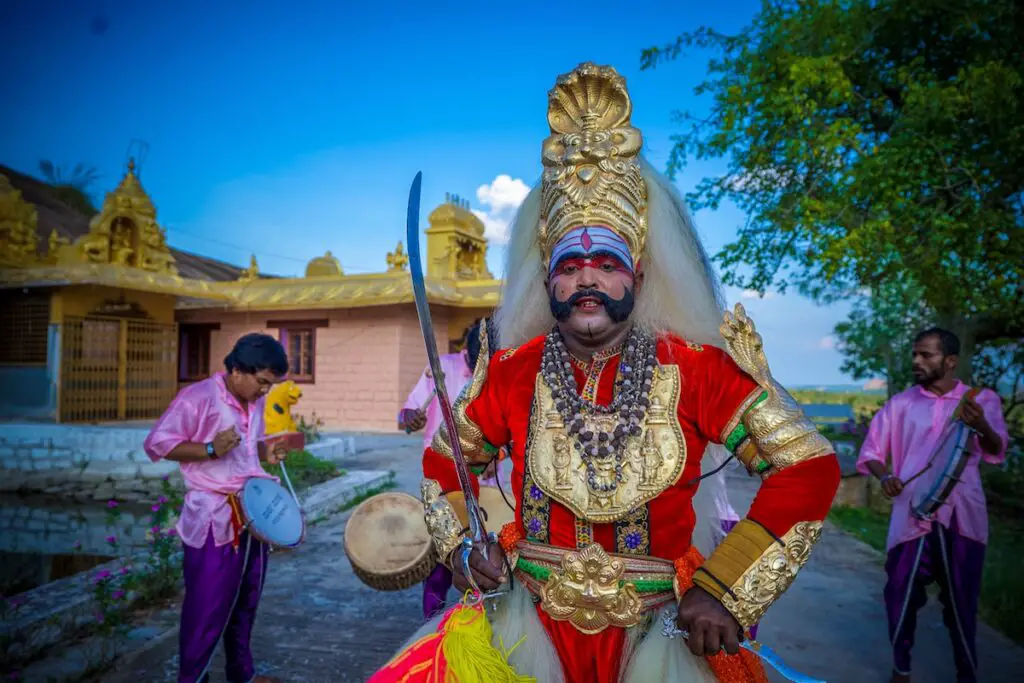
Veeragase is one of the most iconic and popular dances of Karnataka. This dance is mostly performed during the Dussehra festival and Shravana and Karthika ‘Masas’ (months. This dance form has various rules. One is that this dance form can only be performed by angama people from the Veerashaiva or Lingayat clan/community,
The ornament which is worn during this dance is made up of Rudraksha beads. They wore vibhuti and snake resembling dresses. They also carry a wooden plaque and the sword of Lord Veerabhadra.
Now females are also allowed to perform this dance form. Only even means multiple of 8 members are allowed to perform a dance. There will be a person who is having the duty to narrate each dance step and the story behind the dance. There is a story of Daksha yajna story behind the dance.
Various traditional instruments are used in the dance. There is one ritual where dance performers pierce the needle through their mouth
7. Yakshagana
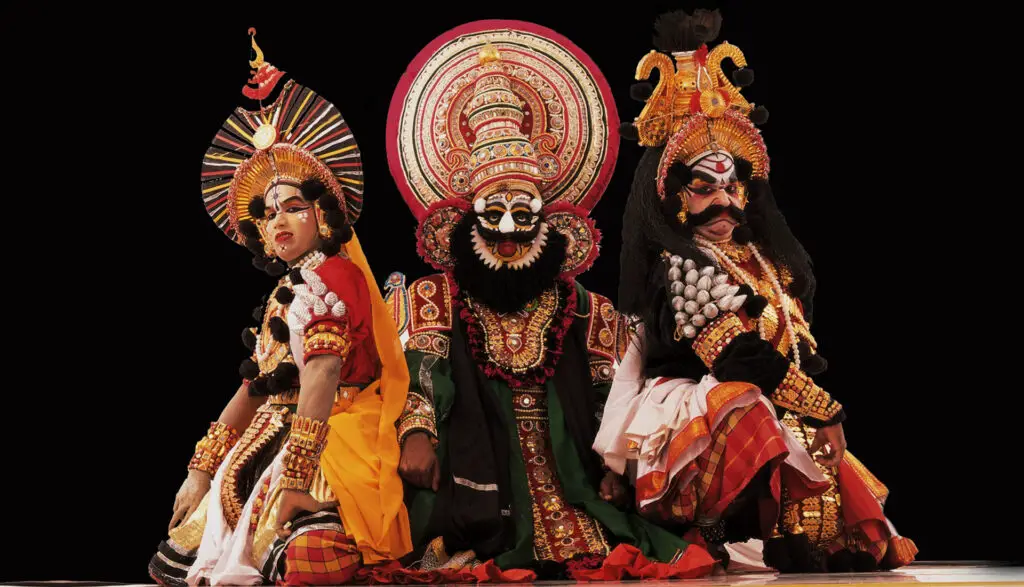
This dance is famous in the coastal district of Karnataka. The performance usually consists of a mix of narrative singing, instrumental music, dance, and dialogue. The costumes worn by the performers are colorful and elaborate and they often represent gods, kings, or other characters. This type of dance has a lot of cultural importance in Karnataka and is also used to tell stories and impart wisdom.
The music accompanying Yakshagana performances consists of main instruments: chende (a drum) Harmonium, Maddale, Taala (mini metal clappers), and flute among others.
The performers sing and dance to the accompaniment of these instruments. This type of dance is usually performed during festivals and special occasions. It is said that this particular form of dance originated between the 11th-16th centuries.
The origins of this ancient dance style may have been influenced by three different sources – theater, worship, and processions which began merging into one art form around the 12th century AD. These days, Yakshagana is considered more than just an art form; it’s considered a living culture that should be preserved and continued.
Large-size headgear is worn in this dance. Faces are painted and elaborate costumes are all over the body and musical beads are on the legs (Gejje). The dance form is very difficult and Performers need great physiques to perform with heavy costumes for several hours and also strong voice and acting/dancing skills.




